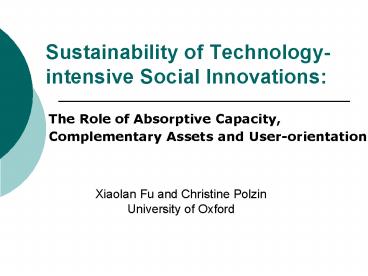Sustainability of Technologyintensive Social Innovations: PowerPoint PPT Presentation
1 / 16
Title: Sustainability of Technologyintensive Social Innovations:
1
Sustainability of Technology-intensive Social
Innovations
- The Role of Absorptive Capacity, Complementary
Assets and User-orientation
Xiaolan Fu and Christine Polzin University of
Oxford
2
Introduction
- Innovation research Traditional focus on
products, services and processes in business
enterprises - ?How to create (and sustain) value?
- Little research on social innovation
- ? Why do potentially useful social innovations
may fail to sustain or to scale up? - Case technology-intensive social innovations in
developing countries
3
Outline
- Introduction
- Theoretical framework
- Methodology
- Case studies
- Findings and Conclusions
4
Theoretical framework (1)
- 1. Social innovation
- Taylor (1970), Gabor (1970)
- Definition by Mulgan et al (2005)
- Innovative activies and services
- Goal meeting a social need
- Predominantly developed and diffused through
organisations whose primary purposes are social - 2. Technology innovation
- Absorptive capacity (Cohen and Levinthal 1990)
- Complementary assets (Teece 1986)
5
Theoretical framework (2)
Absorptive Capacity
Training E-literacy
Social Innovation
Technology Innovation
Complementary assets
Physical Digital capital Human
Organisational Processes Networks partnerships
User-led process
Participatory design
6
Methodology
- Case studies
- Criteria of selection
- Age gt 5 years, beyond pilot-stage
- Business model
- Both third sector and corporate projects
- Both success and failure
- Location Central South India
- Interviewed 9 projects
- 3 typical cases emerge for comparison
7
Methodology
- Comparison of case studies
- Drishtee Microfranchising, e-services kiosks,
initially based on e-governance - N-Logue Microfranchising, e-services kiosks in
clusters of very small villages - E-Choupal (ITC) two-way distribution channel
for procurement sales
8
Case studies (1) - Drishtee
- Source Loonker (2004 154-155)
9
Case studies (2) n-Logue
- Source Jhunjhunwala et al. (2004 33)
10
Case studies (3)- ITC e-Choupals
- Source UNITAR (2005 5)
11
Findings (1)
- Absorptive Capacity
- Participatory skills, education and e-literacy of
kiosk operators - Facilitating skills for the design,
implementation and maintenance of networks - Control skills of governments, influence on
government regulation - Literacy levels, age and income of target groups
12
Findings (2)
- 2) Complementary Assets
- Physical and digital infrastructure,
- Human and organizational processes, improved
business conduct - Generic assets (e.g. networks and partnerships)
- ? Example e-Choupals
13
Example e-Choupals
Human organisational processes
Digital physical infrastructure
Procurement hubs
E-Choupal kiosks
Sanchalaks
Samjojaks
Unbundle price discovery and physical
transactions at the market place
Eliminate inefficiencies inherent in
the physical flow through the market place
Appointed Farmer to handle digital
infrastructure
Former collaborator at the market to
handle physical infrastructure
14
Findings (3)
- 3) User-led process
- Common assumption complete customer freedom of
choice - Constraint interlinked contracts
- Complete end-to-end solutions as feasible social
innovations
15
Conclusions
- Research on technology-intensive social
innovation can benefit from parallels in
established research on traditional technology
innovation - Absorptive capacity and complementary assets as
technology-specific determinants of
sustainability - Usage depends on the degree of freedom of
customers in choosing new products and services - user-led design process
- end-to-end solutions
16
Conclusions (2)
- Limitations
- Sample bias
- Difficult to make generalisations

